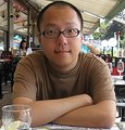 |
|
Postdoctoral Fellow and Adjunct Research Professor, University of New Mexico
Mankei Tsang is a Postdoctoral Fellow and Adjunct Research Professor at the Center for Quantum Information and Control (CQuIC) at the University of New Mexico. He obtained his B.S. degrees in Electrical Engineering and Physics from UCLA in 2002 and his master’s and Ph.D. degrees in Electrical Engineering from Caltech in 2004 and 2006, respectively. He held a postdoctoral fellowship at the Keck Foundation Center for Extreme Quantum Information Theory (xQIT) at MIT, working with Seth Lloyd and Jeffrey H. Shapiro, before moving to his current position in 2010 to work with Carlton M. Caves. His research interests include quantum measurement, estimation, and control theory, quantum optics, nonlinear optics, and nano-optics.
Abstract
Recent work on quantum metrology focuses on the relatively simple problem of parameter estimation, but in realistic applications, the unknown signal of interest, such as a gravitational wave or a magnetic field, is rarely a parameter constant in time but a continuously varying waveform. Here I shall present a quantum limit to waveform estimation in the form of a quantum Cramer-Rao bound (QCRB) [Tsang, Wiseman, and Caves, PRL 106, 090401 (2011)]. Unlike the one first derived by Helstrom for parameter estimation, our QCRB explicitly takes into account the prior information crucial for waveform estimation and the continuous dynamics of the quantum sensor. As an example, we calculate the QCRB for optomechanical force sensing, show that the QCRB is in general below the back-action-enforced Standard Quantum Limit, and demonstrate that the QCRB can be achieved by applying smoothing [Tsang, PRL 102, 250403 (2009)] to the observations and quantum noise cancellation [Tsang and
Caves, PRL 105, 123601 (2010)] to the experimental setup, thus proving the optimality of such techniques.
|



